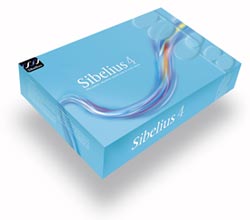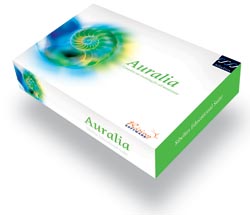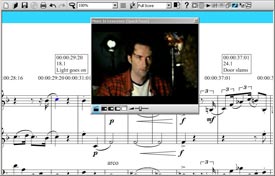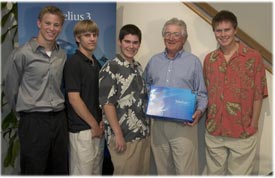Gracenotes
Sibelius USA, Inc. Newsletter – July, 2005
Happy summer, and welcome to the July issue of Gracenotes - our e-mail newsletter to Sibelius enthusiasts in North, Central and South America. This edition of Gracenotes is laden with useful information, interesting articles about and by featured users, and exciting news. Among the exciting news items is the release of Sibelius 4! There are several very major innovations included in Sibelius 4, and we are sure you will agree this is our most advanced upgrade package yet. As part of the introduction, we have included an overview of the amazing new Dynamic Parts™ feature, the first in a series of articles on "What's New in Sibelius 4. This series is written by Daniel Spreadbury, the Sibelius 4 product manager.
For those of you who know Finale users who are reluctant to move to Sibelius, we are happy to share a very insightful article by Michael Boo, a composer/arranger from Indiana and contributing writer for Drum Corps International (DCI). Michael was once reluctant to make the switch; find out what he thinks now.
Educators will be happy to learn that this issue also marks the debut of an extensively upgraded Auralia 3 aural training and testing software. We also provide a link to the John Lennon Songwriting Contest site as a reminder for those interested in participating that contest submissions are now being taken. And congratulations to the Kyle Athayde Quintet, a jazz group from Acalanes High School in Lafayette, California who were recently recognized as the nation's top high school instrumental group by DownBeat magazine.
Our featured user spotlight is a visit with composer, vocalist, director and choreographer Meredith Monk, who has been hailed as a major creative force in the performing arts in a career spanning more than 35 years. As an early practitioner of what is now known as "performance art," the New York-based artist creates works by combining interdisciplinary elements of music, film, atmosphere and movement.
Last, but certainly not least, the Hints & Tips column has been updated with a new and very thorough tutorial to help you with formatting in Sibelius 3. Bruce Munson wrote this one and did a fantastic job.
As always, thanks for your input, and we encourage you to e-mail us at [email protected] to share your thoughts about past, present or future editions of Gracenotes. Enjoy the summer and Happy Reading!
Mark Ruch, Editor
What's New at Sibelius |
|
|
Sibelius Debuts Auralia 3
Sibelius announces the arrival of Auralia 3, the new, extensively updated version of the highly acclaimed Auralia aural training and assessment software from the Australian-based software developer Rising Software. |
Dynamic Parts: The New Revolution in Part Production
Making instrumental parts has long been the element of preparing a score for performance that composers, arrangers and copyists have found most time-consuming. In the days before computers could be utilized, of course, parts were painstakingly copied by hand, and when notation software like Sibelius first appeared, the ability to extract a complete set of instrumental parts in a matter of moments at the click of a button seemed like nothing short of a miracle. Whichever decision you make, you're facing hours of edits. Sure, it's better than re-copying them all by hand, but aren't computers suppose to make this stuff easy? |
Sibelius in the Classroom |
Award-Winning Young Musician Kyle Athayde Gets His Downbeat With Sibelius
The Kyle Athayde Quintet has been honored by DownBeat magazine, the "bible" of jazz musicians and fans, as the nation's top high school instrumental group. The quintet's 17-year-old namesake and leader also won a DownBeat Outstanding Performance award for his solo work on trumpet and vibraphone—one of four since he started entering the competition in 2002, when he captured first place. |
Featured Sibelius Users |
Multi-Faceted Artist Meredith Monk Finds Fluidity With Sibelius
Composer, vocalist, director and choreographer Meredith Monk has been hailed as a major creative force in the performing arts in a career spanning 40 years. A pioneer in what is now called "extended vocal technique" and "interdisciplinary performance," Monk creates works that thrive at the intersection of music and movement, image and object, and light and sound in an effort to weave together new modes of perception. Her diverse career has resulted in operas, musical theater works, film and installations. She has also recorded more than a dozen albums, and has received numerous awards, including the prestigious MacArthur "Genius" Award. |
I Made the Switch: How Sibelius Made Me a Convert
I didn't relish the thought of learning a new music notation program. After being a registered owner of Finale since 1991, I had long since gotten over Finale's substantial learning curve and could certainly be deemed a "power user." But friends kept insisting that I give Sibelius a try, praising its ease of use, its command of projects big and small and its practically non-existent learning curve. Big mistake...big, big mistake. No, trying Sibelius wasn't a big mistake. Waiting as long as I did was the error. To think that for many of my Finale years, I could have been having fun notating my music...arghhh! |
Enter the 2005 JLSC Contest! |
Hints & Tips for Sibelius Users |
Sibelius 3 Formatting By Bruce C. Munson |
When working in Sibelius, the software's auto-formatting features are at work behind the scenes, always making your scores look good. This is because Sibelius would like you to concentrate on your music making rather than on constantly grappling with formatting issues while you are inputting notes. Therefore, it is advisable that you input all of your notes and markings before you make any formatting adjustments. Usually, Sibelius' auto-formatting creates beautiful layouts, so you need not make any additional formatting adjustments. Occasionally you will want to make some adjustments to the layout, and again, it is better and easier to do this after you have finished inputting. However, there are times when you want to format your score before inputting notes. This would be the case with format-intensive layouts like worksheets and perhaps lead sheets. |
Hints & Tips for G7 Users
Check out our on-line archive for a variety of valuable G7 Hints & Tips created by Bruce Munson, U.S. Western Regional Manager for Sibelius. These references also give quick tips for getting started with G7. To download these free resources, please Click Here
Upcoming Training, Shows and Events |
Are you interested in learning more about Sibelius 3? We are offering training sessions in many locations around the U.S. over the next several months. Two types of sessions are available : Sibelius - Beginning, and Sibelius - Intermediate/Advanced.
Training Schedule
| Date | Time | Location | Type |
| Saturday, July 23 | 9 am - 4:00 pm | Los Angeles, CA | Sibelius Beginning Session |
| Saturday, August 6 | 9 am - 4:00 pm | Chicago, IL | Sibelius Beginning Session and Introducing Sibelius 4 |
| Monday or Wednesday evenings in August. Starting August 8 or August 10. | 6 pm - 8:15 pm | New York, NY | Beginning Session - This class meets once a week for 4 weeks. |
| Tuesday or Thursday evenings in August. Starting August 9 or August 11. | 6 pm - 8:15 pm |
New York, NY |
Intermediate/Advanced Session - These classes meet once a week for 4 weeks. |
| Saturday, August 13 | 10-4:30 pm | New York, NY | 1-day Advanced Intensive course. |
| Saturday, August 20 | 10-4:30 pm | New York, NY |
1-day Advanced Intensive course. |
For more information, or to reserve your space, please visit: www.sibelius.com/training
Sibelius will be exhibiting at the following regional seminars, expos and national trade shows:
Upcoming shows and events
| Event | Dates | Location | Booth Number | Link |
| Texas Bandmasters Association | 7/23 - 7/25 | San Antonio. TX | 398 | www.texasbandmasters.org |
In this issue
Sign up
Get occasional e-mails with news and special offers:
Unsubscribe
Stop receiving e-mails from Sibelius:
Settings
Please choose your preferred language and e-mail format settings below. Some e-mails may be sent in English only.
If you're concerned about privacy, click here to view our privacy policy.
Contact us
Sibelius Sales
1407 Oakland Blvd
Suite 103
Walnut Creek, CA 94596
Fax: 925-280-0008
Email: [email protected]







